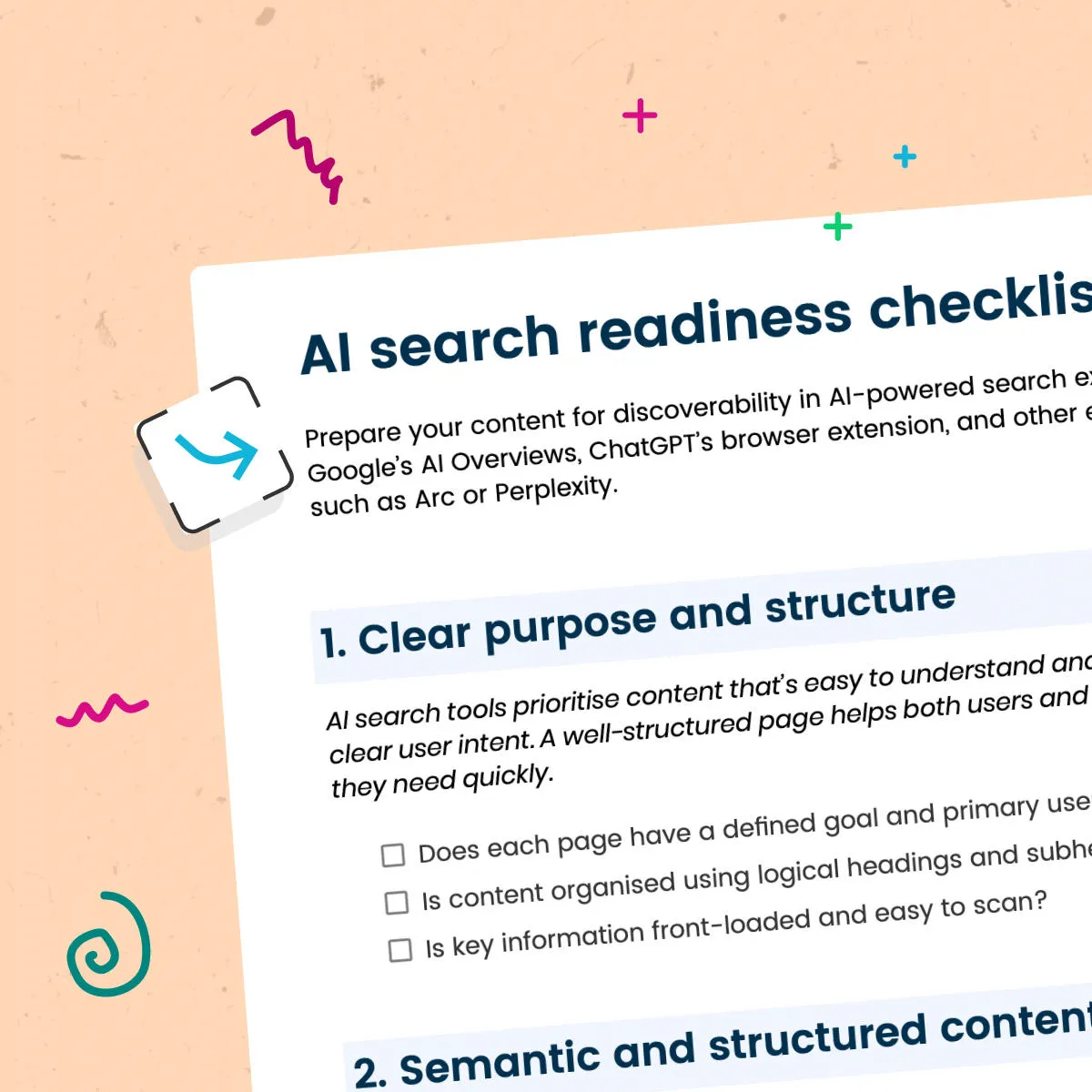How to optimise content for AI-assisted search
The evolution of generative AI, particularly in tools like ChatGPT and Google's Gemini-powered suggestions, is transforming how users discover and interact with digital content. Editors need to optimise their content for these emerging tools and adapt their processes to stay ahead of the game.
Harnessing Google's Gemini and AI search capabilities
Google's Gemini AI ecosystem aims to provide users with smarter and more contextual search results. Features like conversational search through smart devices and AI-powered overviews give users condensed responses with suggestions for follow-up questions and deeper exploration. These features have given rise the increase of "no click searches" where users never actually end up at a website which provided the information.
This means crafting content that answers initial queries and anticipates what users might want to learn next. This will give your content a better chance of making an impact or getting a click through.
For example, an article on "The Benefits of Remote Work" might:
- Start with a clear overview of benefits (e.g., flexibility, cost savings).
- Include subheadings that answer specific questions, such as "How does remote work improve productivity?" or "What are the challenges of remote work?"
- End with a section offering practical advice or additional resources, such as "Top tools for effective remote work".
This structure might not look much different from how you write content now. If this is the case, that means you're focusing on writing quality and engaging articles, which has been the cornerstone of Google's EEAT search initiative for a few years. The main difference is in the expected rise of conversational-style writing along the lines of the dreaded "FAQ" section.

How should you structure articles for AI optimisation?
Here's a quick guide that demonstrates how an editor could structure an article to be more conversational and easily scanned by an AI search tool.
Answer the query upfront
Begin with a short introduction that addresses the user's question. For example, an article titled "How to Choose the Right Running Shoes" might summarise key factors like fit, material, and intended use.
Use question-based subheadings
Break down the content into sections that mirror actual user queries. Use Google's "People Also Ask" feature to generate these questions. Examples include:
- "What should you consider when buying running shoes?"
- "How do different shoes suit various running surfaces?"
- "How do I know my foot type for running shoes."
- "What are the best brands for beginners?"
- "What three factors are important when selecting running shoes?"

Incorporate lists and visual elements
AI-driven search tools favour content that's easy to scan. To present complex information, use bulleted lists, tables, and infographics. For example, a comparison table of shoe features (cushioning, weight, price) can make the article more AI-friendly. Be careful to make sure these elements still meet correct accessibility standards. You can use a tool like insytful to check your content.
Add follow-up sections for related search topics
Anticipate what users might want to learn next. When creating an article, I will usually add an FAQ section after the concluding paragraph to answer queries I've found in Google's related search sections. This trend is continuing with conversational AI-assisted searches.
For example, the article on running shoes could end with sections like:
- "How to care for your running shoes to make them last longer."
- "Running shoes cushioning types."
- "Important of proper running form."
These extra questions keep the user engaged and create opportunities for more content on related subjects.

Optimising for Google and AI search models
Integrate rich keywords
AI-driven search tools value conversational language. Use natural, long-tail keywords like "best running shoes for trail running" or "how to reduce foot pain from running." You can find these terms using a tool like Ahrefs or by typing queries into Google to see what comes back.

Use structured data
Add schema markup to your articles for FAQs, reviews, and how-to sections. This improves visibility in features like snippets and AI-generated overviews. Many platforms, like WordPress, will do this out of the box, but others will require some development work to add these schemas to your pages' markup.
Here’s an example of a basic schema markup for an article about the best running shoes. This is written in JSON-LD format, which is widely used for structured data:
<script type="application/ld+json">
{
"@context": "https://schema.org",
"@type": "Article",
"headline": "The Best Running Shoes for 2025",
"description": "A comprehensive guide to the top running shoes for all types of runners, including reviews and recommendations.",
"author": {
"@type": "Person",
"name": "Jane Doe"
},
"publisher": {
"@type": "Organization",
"name": "Running World",
"logo": {
"@type": "ImageObject",
"url": "https://www.runningworld.com/logo.png"
}
},
"datePublished": "2025-01-15",
"dateModified": "2025-01-18",
"mainEntityOfPage": {
"@type": "WebPage",
"@id": "https://www.runningworld.com/best-running-shoes-2025"
},
"image": [
"https://www.runningworld.com/images/best-running-shoes-1.jpg",
"https://www.runningworld.com/images/best-running-shoes-2.jpg"
],
"articleSection": "Running Gear Reviews",
"keywords": "running shoes, best running shoes 2025, top running gear",
"aggregateRating": {
"@type": "AggregateRating",
"ratingValue": "4.8",
"reviewCount": "120"
}
}
</script>
Include links to authoritative sources
Gemini and ChatGPT prioritise content that demonstrates expertise and credibility.
To build trust and authority:
- Cite reliable sources: Link to studies, reports, and statistics from trusted organisations or academic institutions. For example, referencing a study on running shoe performance from a respected sports science journal adds weight to your claims.
- Use data to back up your points: Include useful metrics or benchmarks. Instead of saying, "These shoes are lightweight," specify, "At only 250 grams, these shoes are 15% lighter than the average running shoe, according to [Source]."
- Partner with authoritative sites: Aim to have your content referenced or linked by high-quality, credible websites. This could involve collaborating with industry blogs, universities, or recognised experts. For instance, sharing your guide with organisations like the British Journal of Sports Medicine could encourage valuable backlinks, boosting your domain rating and article visibility in search.
Keeping content fresh and relevant
AI models like Gemini prioritise content that is not only up-to-date but also relevant and insightful. To make your content stand out, it's important to go beyond updating the publication year. Refresh your material with updates that reflect current developments, tools, and best practice.
For example, an older article on "Digital Marketing Strategies" can be revised to include the latest data, case studies, and cutting-edge tools, such as AI-driven platforms for campaign management. Trends like the rising popularity of platforms such as TikTok or Snapchat for AI search among Gen Z can provide valuable context and keep the content relevant to the audience.
Outdated recommendations should be re-evaluated and replaced with alternatives that reflect the industry's current state. By consistently revising content, you establish your work as reliable and forward-thinking, meeting the standards that both AI systems and human readers appreciate.
The future of AI-assisted search
Gemini-powered search, ChatGPT search, and other AI tools are changing how people find and interact with information.
By creating content that plays to AI's strengths—providing precise, relevant, and context-rich answers—you can meet user expectations while standing out in search results. Think about how your content serves its audience: is it direct, well-organised, and genuinely helpful? If you can keep answering these questions with quality up-to-date content, you'll stay ahead of the rest of the market.








